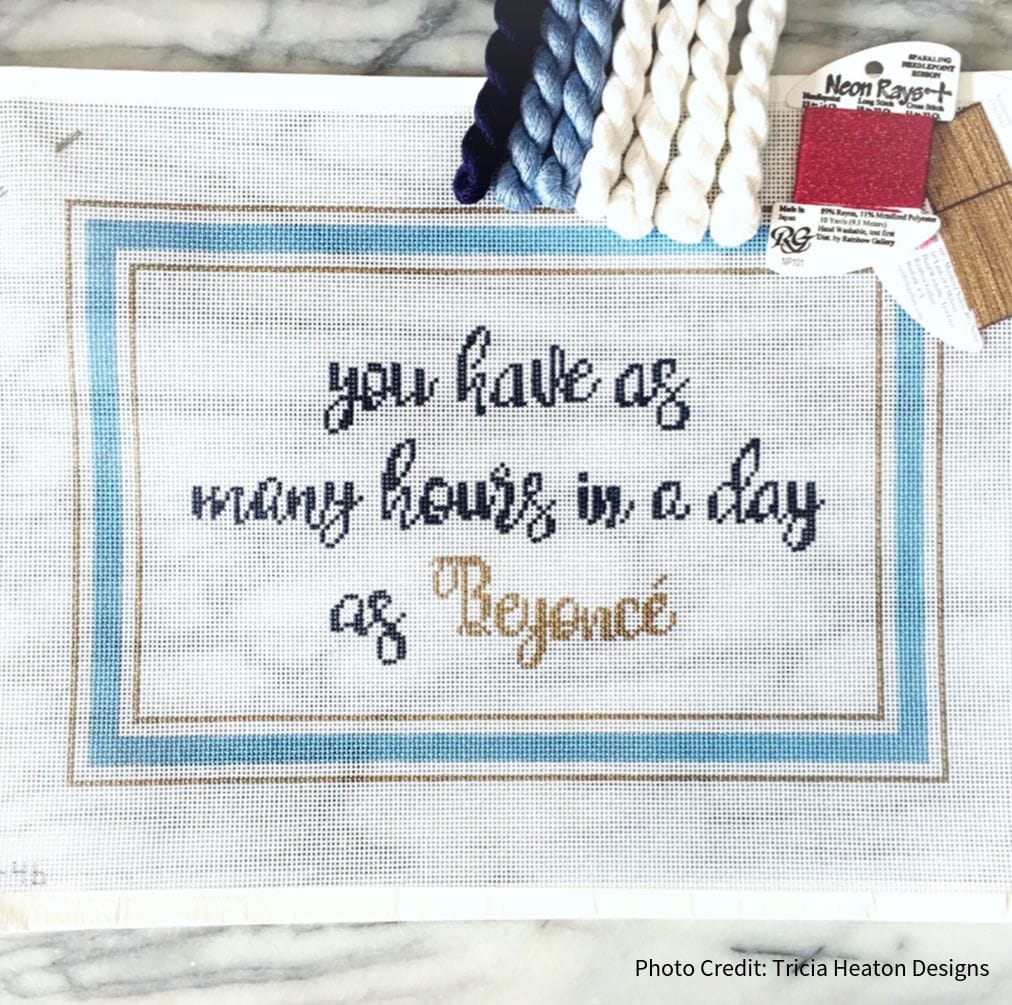Do you struggle with finding enough time to stitch? And even more – do you wonder where all your time goes? If you’re tired of never having enough time to work on your needlepoint projects, you’re gonna L-O-V-E this blog post! Ready to dive in?
Alrighty – let’s get started…
You know you can’t quit your job. (At least, not yet.) And you can’t ignore family commitments and responsibilities. If you want to find time to work on your needlepoint projects, it’s up to you to make that happen.
So, how do you do it?

Here are five simple – and proven – steps you can take…
1. Decide you really want to spend an hour of your time (or whatever suits you) on your needlepoint project every day.
Everybody knows that the first step to financial success is committing to a budget. And that budget is often influenced by your goals. Maybe you want to pay off your mortgage within five years. Or maybe you just want that new canvas you saw at your local needlework shop.
Now, whaddya say we transfer that analogy to your needlepoint hobby – what are your goals? Do you want to finish some of your UFOs? Stitch a stocking for your new grandchild? Learn 10 new decorative stitches you can use on your canvases?
Write these down, and put them somewhere you can see them every single day. And get ready for “Resistance” to rear its head. You know – it comes in the form of those excuses that sneak up on you. And life – well, it sometimes gets in the way, too.
But if you’re excited about spending time with your favorite hobby, that’s the first step.
2. Be realistic.
That may sound like a “no-brainer”, but it’s the #1 thing that can stop you in your tracks. Let’s put that into perspective with another money metaphor…
You wouldn’t set a $100 budget for eating out if you only had $25 in extra cash each week. Likewise, you need to be realistic about the time you can commit to stitching. If you’re juggling a busy schedule, a fifteen-minute stitching session every day may be all you can find time for right now.
Pencil your stitching session in on your calendar or put a reminder on your smartphone because, as the saying goes, “if it ain’t written, it ain’t real”. If you don’t put it on your calendar, you won’t do it. Trust me on this one…
3. Add these time-saving tricks to your toolbox.
If you’re really good at budgeting your money, you probably know lots of little tricks. You wait for terrific deals, clip coupons, keep an eye out for discount codes, etc. And there are little tricks you can use when it comes to budgeting your time, too.
If you take a really close look at your schedule, you may find that you have extra time in your day that you can use for stitching. Of course, that may mean cutting back on the time you spend browsing Facebook and Instagram.????
I’ll bet you were expecting that advice, weren’t you?
But hey – here are some more time-saving tips you can try…
- Make a weekly menu – and include lots of slow cooker recipes. Let your Crock-Pot do the work, leaving you more time to stitch.
- Take advantage of your lunch hour. If your employer allows it, consider brown bagging from home and stitch during your lunch break. If you prefer to get out of the office, take your needlepoint to a coffee shop or some other public space. (And in the warm weather months, head to the park.)
- Set the alarm clock for earlier. Getting up just one hour earlier can give you that extra time you’ve been craving. Curl up in your favorite stitching chair with a warm cuppa before everybody else starts their day – and stitch to your heart’s content (or until your hour is up).
- Take advantage of commuting (or waiting room) time. It’s amazing how many stitches you can make in a short period – even as little as 15 minutes!
- Join a local stitching group (or the Serendipity Needleworks Stitcher’s Club!). Having stitch-y friends to share your successes with (and to learn from or bounce ideas off of) is incredibly motivating.
4. Adjust as needed.
Budgets ebb and flow — unplanned bills show up and “can’t-miss” opportunities arise. The best financial advice is to be flexible and review your budget frequently. And sometimes the time you’ve budgeted doesn’t go as planned. I know – life can get reeaaalllly busy. But don’t beat yourself up if you need to re-schedule a stitching session or two.
Keep a positive attitude – and fit in however much time you can! Just get back on track as soon as possible.
5. Take care of yourself.
One of the best financial tips out there is to pay yourself first. And just what does that mean? When it comes to your finances, it means setting aside money for your future self before anything else. (Think emergency funds, retirement accounts, etc.)
So, how does that apply to your needlepoint hobby? Well, you can use the same strategy to plan how you want to spend your free time.
Wanna finish some of those UFOs? Completing projects that have been lingering for far too long not only cleans out your stash drawer, but it also clears your head – and it just makes you feel a whole lot better in general.
Wanna become a more confident stitcher? It takes practice to develop your needlepoint skills and when you get those extra hours of stitching in every week, your confidence is sure to soar.
Or maybe you just wanna relax. I’ve stitched oodles of projects entirely in basketweave because I thoroughly enjoy the rhythmic motion of tent stitch.
It brings me joy – and who can ever have enough of that?! So the question is… do you want to invest in yourself?
When you think of it that way, making time for stitching seems like a no-brainer, doesn’t it?

Now that you have some guidelines to help you find more time to stitch, I’m curious. Which one(s) are you gonna try first? Tell me in the comments box below. You know I ❤️hearing from you and I read every single note.
Until next time, happy stitching!
XOXO!!! ❤️





